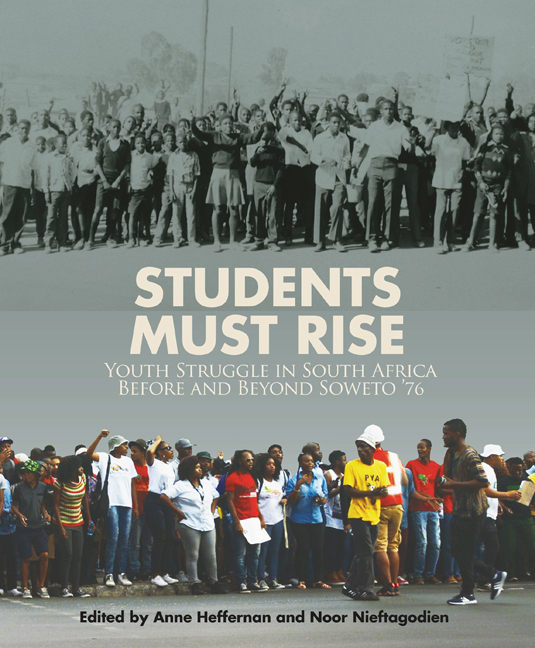Book contents
- Frontmatter
- Acknowledgements
- Contents
- Timeline
- Map Of South Africa
- Glossary
- Abbreviations
- Introduction: narratives of the student struggle
- Chapter 1 A brief history of the African Students’ Association
- Chapter 2 Youth and student culture: Riding resistance and imagining the future
- Chapter 3 The role of religion and theology in the organisation of student activists
- Chapter 4 Student organisation in Lehurutshe and the impact of Onkgopotse Abram Tiro
- Chapter 5 The University of the North: A regional and national centre of activism
- Chapter 6 Action and fire in Soweto, June 1976
- Chapter 7 What they shot in Alex
- Chapter 8 SASO and Black Consciousness, and the shift to congress politics
- Chapter 9 Youth politics and rural rebellion in Zebediela and other parts of the “homeland” of Lebowa, 1976–1977
- Chapter 10 My Journey, our journey: Activism at Ongoye University
- Chapter 11 ‘Let's begin to participate fully now in politics’: Student politics, Mhluzi township, 1970s
- Chapter 12 ‘They would remind you of 1960’: The emergence of radical student politics in the Vaal Triangle, 1972–1985
- Chapter 13 The ends of boycott
- Chapter 14 Fighting for ‘our little freedoms’: The evolution of student and youth politics in Phomolong township, Free State
- Chapter 15 ‘Every generation has its struggle’: A brief history of Equal Education, 2008–15
- Chapter 16 Contemporary student politics in South Africa: The rise of the black-led student movements of #RhodesMustFall and #FeesMustFall in 2015
- Selected Bibliography
Chapter 7 - What they shot in Alex
Published online by Cambridge University Press: 21 April 2018
- Frontmatter
- Acknowledgements
- Contents
- Timeline
- Map Of South Africa
- Glossary
- Abbreviations
- Introduction: narratives of the student struggle
- Chapter 1 A brief history of the African Students’ Association
- Chapter 2 Youth and student culture: Riding resistance and imagining the future
- Chapter 3 The role of religion and theology in the organisation of student activists
- Chapter 4 Student organisation in Lehurutshe and the impact of Onkgopotse Abram Tiro
- Chapter 5 The University of the North: A regional and national centre of activism
- Chapter 6 Action and fire in Soweto, June 1976
- Chapter 7 What they shot in Alex
- Chapter 8 SASO and Black Consciousness, and the shift to congress politics
- Chapter 9 Youth politics and rural rebellion in Zebediela and other parts of the “homeland” of Lebowa, 1976–1977
- Chapter 10 My Journey, our journey: Activism at Ongoye University
- Chapter 11 ‘Let's begin to participate fully now in politics’: Student politics, Mhluzi township, 1970s
- Chapter 12 ‘They would remind you of 1960’: The emergence of radical student politics in the Vaal Triangle, 1972–1985
- Chapter 13 The ends of boycott
- Chapter 14 Fighting for ‘our little freedoms’: The evolution of student and youth politics in Phomolong township, Free State
- Chapter 15 ‘Every generation has its struggle’: A brief history of Equal Education, 2008–15
- Chapter 16 Contemporary student politics in South Africa: The rise of the black-led student movements of #RhodesMustFall and #FeesMustFall in 2015
- Selected Bibliography
Summary
June 16, 1976 is one of the most photographed moments in South African history. When the photojournalist Sam Nzima took the picture of 13-year-old Hector Pieterson dying in the arms of Mbuyisa Makhubu, he could not have known that, with that click of the camera, he would be marking a historical turning point. This picture has travelled all over the world and has become the iconic image of the June 16, 1976 student revolt. The picture said it all, so to speak. But this is not the only visual story to be told.
This photographic essay is made up of moments captured by the police photographers and embedded reporters. The essay revisits June 16, 1976 through their lenses. It looks at what they saw and what they shot. The essay is made up of 16 images from Alexandra Township in Johannesburg. The police photographer pointing his camera at the children, just like the policeman pointing a gun, is a missing voice in the historiography of the June 16 student revolt. These unnamed photographers came with the police to document the “riots”. The photographers’ lenses were there to pick up evidence of “rioting” and destruction. The photographs used in this essay were compiled as part of the Cillie Commission, which was tasked to investigate the causes and consequences of the June 16 uprising for the government of the day. Although the photo essay is an open-ended conversation made up of a subjective selection of images, (pictures that moved me) it is also guided by two impulses: first, to show that June 16 started in Soweto but it ignited fires in other parts of the country, thus the focus on Alexandra, and second, because the pictures are shot from the sky, or from behind the police line, they reveal something disturbing about the confrontation between the white riot policeman and the African child, both caught in a fiery historical moment.
- Type
- Chapter
- Information
- Students Must RiseYouth struggle in South Africa before and beyond Soweto ’76, pp. 65 - 97Publisher: Wits University PressPrint publication year: 2016



